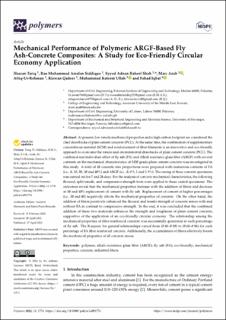| dc.contributor.author | Tariq, Hassan | |
| dc.contributor.author | Siddique, Rao Muhammad Arsalan | |
| dc.contributor.author | Shah, Syyed Adnan Raheel | |
| dc.contributor.author | Azab, Marc | |
| dc.contributor.author | Rehman, Attiq Ur | |
| dc.contributor.author | Qadeer, Rizwan | |
| dc.contributor.author | Ullah, Muhammad Kaleem | |
| dc.contributor.author | Iqbal, Fahad | |
| dc.date.accessioned | 2023-04-03T08:48:10Z | |
| dc.date.available | 2023-04-03T08:48:10Z | |
| dc.date.created | 2022-10-10T19:51:12Z | |
| dc.date.issued | 2022 | |
| dc.identifier.citation | Tariq, H., Siddique, R. M. A., Shah, S. A. R., Azab, M., Qadeer, R., Ullah, M. K., & Iqbal, F. (2022). Mechanical performance of polymeric ARGF-based Fly ash-concrete composites: a study for eco-friendly circular economy application. Polymers, 14(9), 1774. | en_US |
| dc.identifier.issn | 2073-4360 | |
| dc.identifier.uri | https://hdl.handle.net/11250/3061684 | |
| dc.description.abstract | At present, low tensile mechanical properties and a high carbon footprint are considered the chief drawbacks of plain cement concrete (PCC). At the same time, the combination of supplementary cementitious material (SCM) and reinforcement of fiber filaments is an innovative and eco-friendly approach to overcome the tensile and environmental drawbacks of plain cement concrete (PCC). The combined and individual effect of fly ash (FA) and Alkali resistance glass fiber (ARGF) with several contents on the mechanical characteristics of M20 grade plain cement concrete was investigated in this study. A total of 20 concrete mix proportions were prepared with numerous contents of FA (i.e., 0, 10, 20, 30 and 40%) and ARGF (i.e., 0, 0.5, 1 and 1.5%). The curing of these concrete specimens was carried out for 7 and 28 days. For the analysis of concrete mechanical characteristics, the following flexural, split tensile, and compressive strength tests were applied to these casted specimens. The outcomes reveal that the mechanical properties increase with the addition of fibers and decrease at 30 and 40% replacement of cement with fly ash. Replacement of cement at higher percentages (i.e., 30 and 40) negatively affects the mechanical properties of concrete. On the other hand, the addition of fibers positively enhanced the flexural and tensile strength of concrete mixes with and without FA in contrast to compressive strength. In the end, it was concluded that the combined addition of these two materials enhances the strength and toughness of plain cement concrete, supportive of the application of an eco-friendly circular economy. The relationship among the mechanical properties of fiber-reinforced concrete was successfully generated at each percentage of fly ash. The R-square for general relationships varied from (0.48–0.90) to (0.68–0.96) for each percentage of FA fiber reinforced concrete. Additionally, the accumulation of fibers effectively boosts the mechanical properties of all concrete mixes. | en_US |
| dc.language.iso | eng | en_US |
| dc.publisher | MDPI | en_US |
| dc.rights | Navngivelse 4.0 Internasjonal | * |
| dc.rights.uri | http://creativecommons.org/licenses/by/4.0/deed.no | * |
| dc.title | Mechanical Performance of Polymeric ARGF-Based Fly Ash-Concrete Composites: A Study for Eco-Friendly Circular Economy Application | en_US |
| dc.type | Peer reviewed | en_US |
| dc.type | Journal article | en_US |
| dc.description.version | publishedVersion | en_US |
| dc.rights.holder | The authors | en_US |
| dc.subject.nsi | VDP::Teknologi: 500 | en_US |
| dc.source.pagenumber | 0 | en_US |
| dc.source.volume | 14 | en_US |
| dc.source.journal | Polymers | en_US |
| dc.source.issue | 9 | en_US |
| dc.identifier.doi | 10.3390/polym14091774 | |
| dc.identifier.cristin | 2060226 | |
| cristin.ispublished | true | |
| cristin.fulltext | original | |
| cristin.qualitycode | 1 | |

